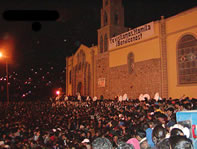| Oruro is home to Bolivia's biggest Carnival! It is described by Rough Guide as one of the most spectacular cultural events in all of South America. Like Mardi Gras in New Orleans, it's a time for revelry celebrated just before Lent. Oruro is a nondescript town that was formerly the center of a highly productive tin mining industry in the 20th century. It is a three hour bus ride south from La Paz. The origins of Oruro as the site of Carnival date back to miracles performed by the Virgin del Socavon (the patron saint of miners) here and, indeed, the event is carried out in her honor. Carnival attracts teams of dancers and bands from all over the country. On-site estimates for the 2005 festival placed the number of dancers at 14,000 and the number of musicians at 6000, and visiting dignitaries often include the president of the country. Spectators at Carnival routinely don ponchos or other outer wear to protect themselves against the playful barrage of water balloons and foam-spewing cans and guns aimed at anyone (no exemptions) by children and many adults during the week-long Carnival period. No one escapes some degree of dousing. Carnival centers around an amazing and seemingly endless procession of dance groups dressed in fantastic costumes depicting religious and folk themes. Many of the costumes depict El Diablo – the devil – and the devil’s consorts, with exaggerated seductive features of a temptress. In a mix of Catholicism and native Andean beliefs, the devil is seen as the Lord of the Underground who will not cause trouble as long as he is given his due. There are also other themes as well, for example, the hard lives of the miners and the sad plight of slaves imported to work in the silver mines. There were groups that represented the legendary Incas and other aspects of Bolivia's heritage. And there is the enduring theme of good vs. evil as reflected by depictions of the Archangel Michael. Juxtaposed with this Christian theme are marchers and floats that pay homage to Pachamama (Mother Earth). This pre-Colonial concept is a still-powerful belief that strongly influences the daily thought of most Bolivians. In addition to traditional Carnival themes is a newer emphasis - the celebration of youth and beauty -- underscored by the participation of attractive young women in striking costumes, marching unmasked. The costumes are seldom subtle. The majority of the dancers were masked and the masks and costumes were often a statement of excess. In almost all masks, eyes were bulging and ringed for further emphasis. Ears were pointed and elongated. Many had horns or fangs. A fair number of the masks were sculpted as skeletons. Sometimes, skulls or caricatures of other animal heads or bodies hung from the shoulders, arms or waists of the dancers – with who knows what meaning . Many dancers wore headdresses that extended upward and outwards six feet or more, with some representing fire-breathing dragons and others simply wildly decorative. Some dancers had large pipes in their mouth out of which streamed purple smoke. Firecrackers and smoke bombs were set off along side the dance groups by accompanying aids. Among the most dramatic costumes were those that represented the Amazonian region of Bolivia. These groups were clad in animal-like skins and their costumes were replete with giant feathers in riotous colors. On the first day, the extravaganza began at 7:00 am and groups from all over Bolivia paraded, marched, danced, pranced, leapt and twirled along the three mile route that ended at the Santuario del Socavon (Sactuary of the Miners), where the dancers got down on their knees to enter the church. The final participants did not reach the church until well after midnight. A few hours later (before dawn), thousands of the participants and spectators gathered in front of the church, swaying rhythmically to the hypnotic devil-theme melody played over and over by bands seated in front of the church.
We inched our way through the swaying mass of humanity in a human chain (wondering whether we might be crushed in the process), and made our way to a vantage point above the proceedings. While religious and folk themes dominated the first hours of Carnival, by the end of the first day, the mood had mostly been transformed into one of revelry and, for many, drunkenness. All-in-all, Carnival was an amazing and colorful event. For
Bolivian Tour
|


